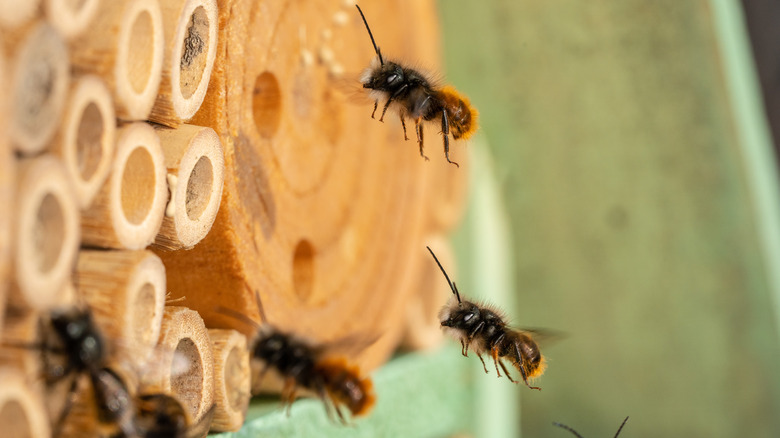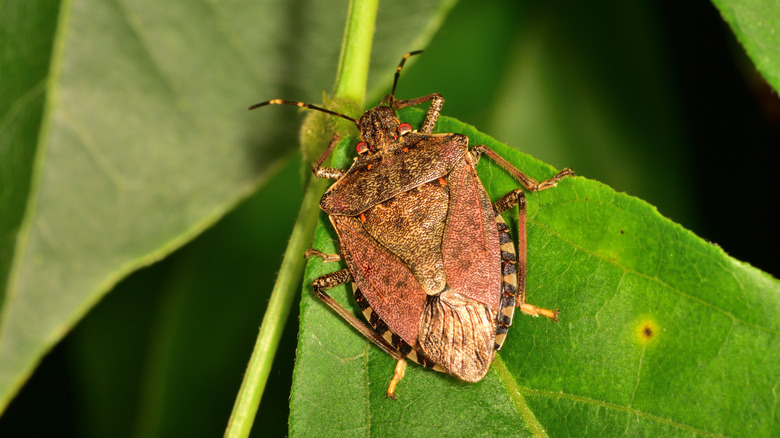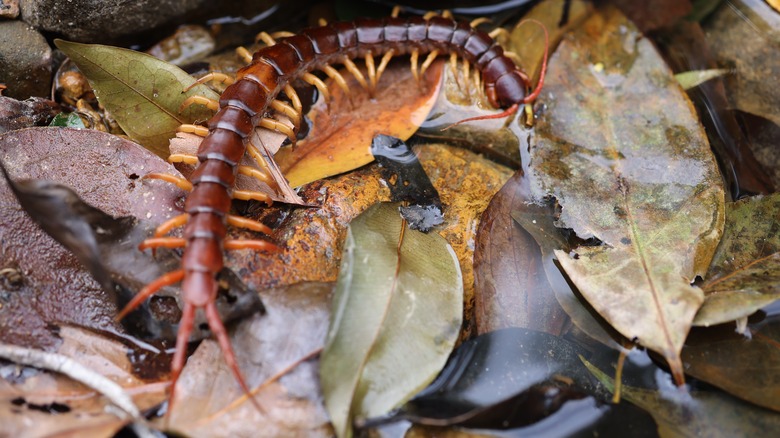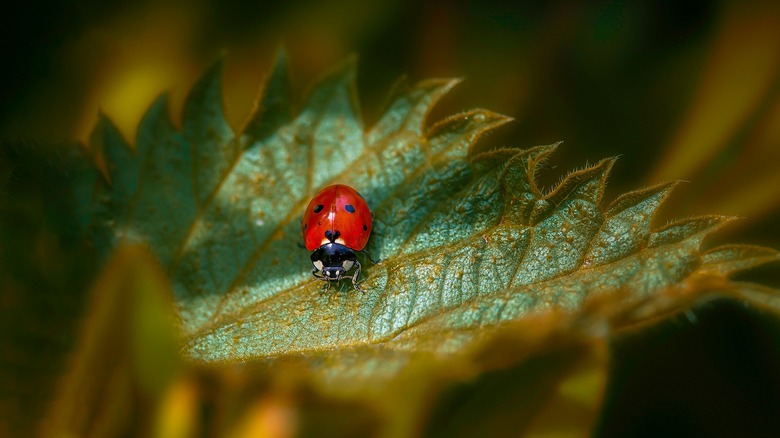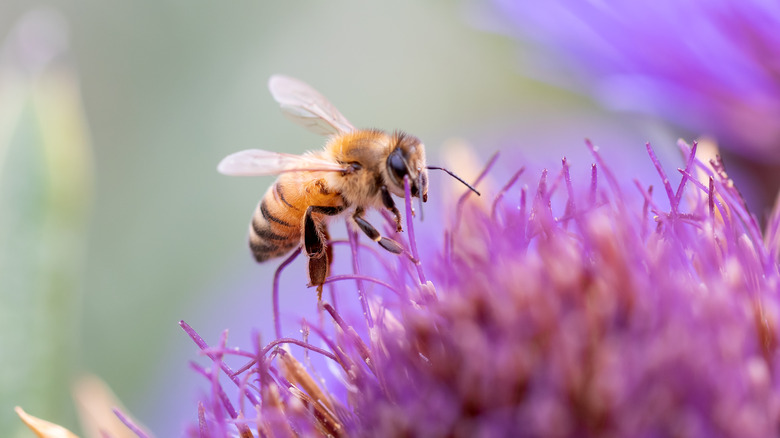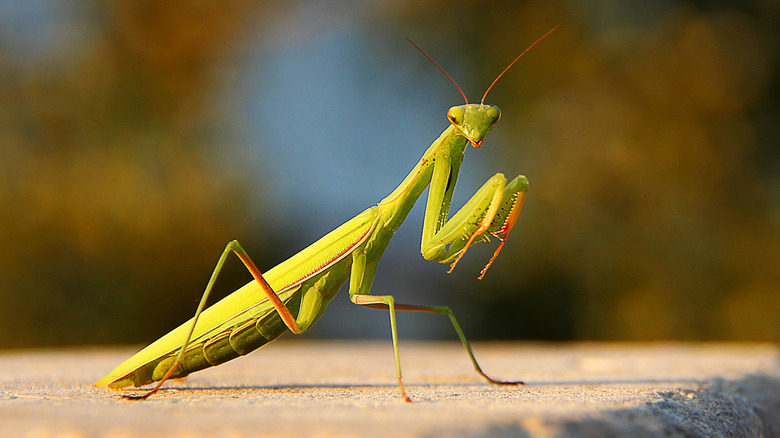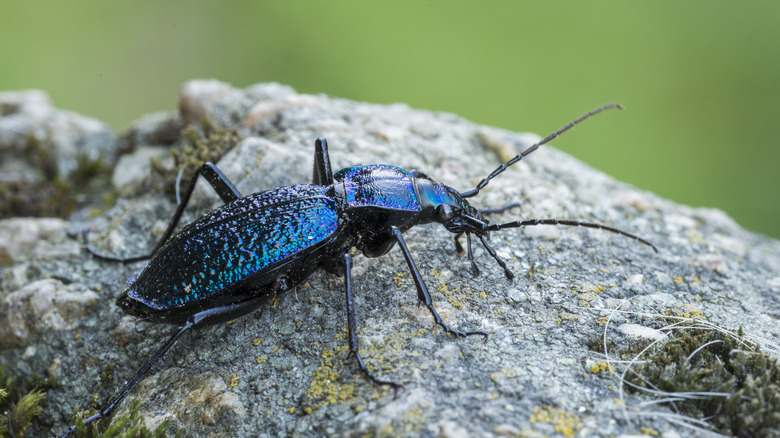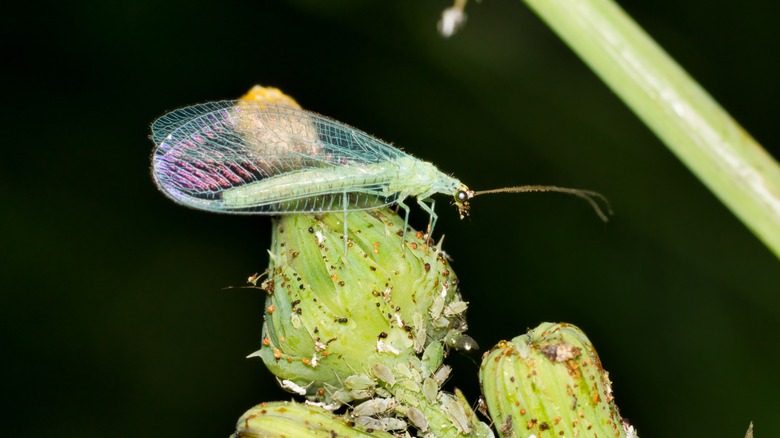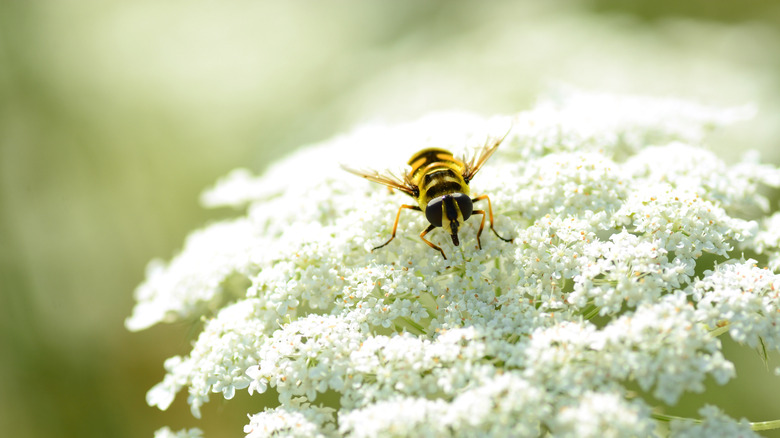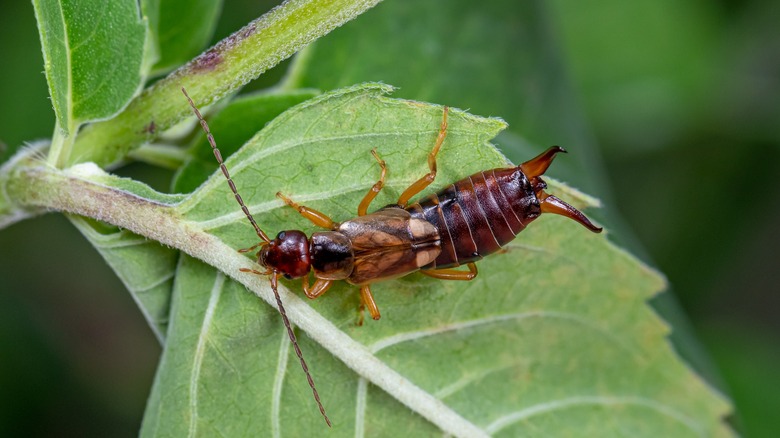Insects You Should Avoid Killing At All Costs
We may receive a commission on purchases made from links.
Most would prefer not to turn their home into an all-exclusive insect hotel. Similarly, seeing bugs crawling around your garden can be concerning. However, many creepy crawlies can benefit your home and garden by helping to fight unwanted and damage-causing pests. For example, spiders (though technically arachnids and not insects) can be beneficial to have indoors. Most house spider species are harmless to humans and only want to bite and feed on smaller prey like ants, moths, and other household pests. Likewise, several types of insects, though they may creep you out, won't cause any harm to you or your home's structure.
Though you don't want to kill every bug that crosses your path, it doesn't mean you must let them take over. If you notice a surplus of insects sneaking in, it's a good idea to start taking preventative measures. Search and fill in any cracks where tiny intruders can get through. Eliminate food sources by properly storing and promptly removing trash and keeping food items in airtight containers. Avoid leaving standing water in your home and garden. Birdbaths, puddles, pet bowls, and other sources allow nuisances like mosquitos to lay eggs. Even with safeguards, it isn't impossible to cross paths with a bug or two in an otherwise perfectly tidy home. However, before you reach for your pesticide bottle, first ensure you familiarize yourself with the species you're dealing with. Here are nine insects you should avoid killing at all costs.
Stink bugs
Despite the off-putting name, stink bugs aren't the worst insects to have in your home. Most of them won't sting or bite. That said, while a bite from one of the rarer species may hurt, they're non-venomous and won't spread any diseases. There are over 200 species in North America, so while they aren't harmful, you probably still don't want this invasive species roaming around the house. However, killing them isn't a great idea either. If feeling threatened or crushed, they'll release a foul-smelling chemical that's more powerful than you'd think. Additionally, some species feed on armyworms, certain types of beetles, and other damaging insects. Unfortunately, the other group of stink bugs enjoys eating crops, so it's crucial to classify the ones you're dealing with.
Stink bugs tend to appear in early spring or summer, so it's an ideal time to ensure your windows are sealed and there aren't any cracks they can get through. The easiest way to distinguish between the good and bad guys is by looking at the tops of their bodies. Predatory stink bugs, the beneficial kind, will have sharp shoulder spines, and their antennas will be one shade with no white banding. To catch them, use a plastic baggie to pick them up and release them outdoors near your garden so they can fulfill their pest-control duties. As for the other types of stink bugs, release them away from your garden. Spray your garden plants to repel stink bugs and other common garden pests. You can use plenty of natural ingredients to repel stink bugs without resorting to pesticides, like neem oil.
Centipedes
Centipedes may look like something out of a horror movie, but are they really as bad as they seem? These leggy creatures can be jarring to look at, so most people's first instinct is to remove them from their homes immediately. However, if you can get past their unsightly appearance, you may want to reconsider squishing centipedes and instead let them share your living space. They won't snack on any food you leave out, but instead, they will spend most of their time hunting small pests like ants, termites, and some spider species. Additionally, those living outside won't eat any of your garden crops; they'd rather feed on bugs that cause damage to your plants. So they can be helpful little garden buddies. House centipedes don't create nests, destroy fabric, or cause any structural damage. They typically don't bite and will run away from humans, though they may lash down if feeling cornered.
They come inside to protect themselves from the cold environs and lay their eggs — peak centipede season is usually in spring and autumn. If you decide you don't want to be housemates with a centipede, there are ways to prevent them from coming into your house. House centipedes usually make their home in damp areas like crawl spaces, basements, and bathrooms. Seal any crevices in your basement walls and install a screen in any floor drains to keep them from coming through dry sump pumps. Encourage outdoor centipedes to help tend to your garden by providing plenty of moist soil and shady areas with compost, logs, and rocks.
Ladybugs
Despite being insects, ladybugs' bright and colorful appearance makes them pretty adorable creatures. However, they're more than just a cute face. Also known as ladybirds, these tiny bugs are one of the most effective safeguards against soft-bodied pests that wreak havoc on house and garden plants. They can consume 50 or more aphids daily and feed on other crop-damaging irritants like mites, mealy bugs, scales, and more. Because they help eliminate most of what gardeners have nightmares about, they're even available to buy as pest control. So consider providing them shelter in the winter and using them to control pests in warmer months.
Aside from the occasional smell, there aren't many downsides to coexisting with the little red beetles, but if you want to keep them out of your house, there are a couple of safe, harmless methods to do so. If you already have them in your home, capture them in a jar and release them outdoors, ideally near your garden if you have one. Using a bug vacuum, like this one from Amazon, to suck them up is another option you can use, especially if you have an infestation. Once you've collected them all, release them outdoors. If you continue to have issues, you may need to hire a professional to identify and fix their entryways thoroughly.
Honey bees
Although honey bees have stingers, they aren't as big of a threat as you may think. Honey bees are vital for pollinating crops and flowers, so killing them ultimately hurts the ecosystem. If bees become extinct, the plants they pollinate will also die, eliminating food sources and habitats for millions of species. This seemingly small change could make the food network fall apart, creating a domino effect that would eventually destroy our planet. Currently, bee populations are decreasing at frightening rates. So go easy on them if you see them — seeing our fuzzy, black-and-yellow-striped friends buzzing around the garden is a sign that it's thriving, so it's best to let them enjoy their lunch. Despite misconceptions, honey bees are relatively docile and will likely only sting when they feel threatened.
While having pollinators in your yard is one thing, having them in your home isn't ideal for anyone. You'll want to get the honey bees outside while causing the least harm possible. If there are only a couple of bees, you can use a bug vacuum to suck them up before freeing them outdoors, preferably by nectar-rich plants, so they can buzz on their way and return home. An infestation can be a bit trickier to manage and is better handled by a professional. However, rather than calling an exterminator, contact a beekeeper who can safely relocate them. To keep honey bees thriving in your garden, you can purchase a bee hotel like this one from Amazon — just make sure there are plenty of flowers for food nearby.
Praying mantises
Praying mantises are visually one of the most interesting creatures you can find in nature. Aptly named, they have bent forearms that make this insect look like it's about to pray. These predators are quick, snatching up prey with such speed that you'd miss it if you weren't paying close attention. Because they mostly eat insects, they can be a real benefit to your garden. You may have heard the myth that killing these unique little green creatures is illegal, but that isn't the case. Still, if you happen upon one, it's best to let it do its thing rather than harm it.
Although you're more likely to find smaller insects sneaking into your home, stumbling upon a praying mantis is not impossible. Some people even purposely bring them indoors to keep as pets since they're relatively low-maintenance. However, if you aren't looking to take care of the little green guy, you can safely return him to his natural home outdoors. Slowly approach the praying mantis and gently place a small container over it. Slide a piece of paper or thin cardboard underneath the cup, trapping it inside. When releasing, choose a sheltered spot, like a bush, where the mantis can find refuge. Mantises might look scary, but they're actually beneficial to your garden, as they're prolific ambush predators and will help keep pest populations in check. If you see one inside or around your home, though, make sure to research whether or not it's an invasive species of mantis.
Ground beetles
Saying that ground beetles aren't the cutest insect would be an understatement. Their cockroach-like appearance unsettles many homeowners, making it hard to resist the urge to grab the Raid. However, ground beetles are handy little bugs to have in your garden, as they help keep snails and slugs out of your garden. They also hunt for common plant enemies like aphids and help keep the soil healthy for crops and flowers. Although a bit creepy, they're more of a nuisance than anything when indoors. They don't destroy buildings and won't reproduce inside your home. They may pinch if mishandled, but they otherwise won't unless provoked.
Rather than trying to terminate any ground beetles in your garden, do what you can to encourage them to stay and help control pests. Add leaf litter, rocks, or mulch to give them a place to hide and rest during the day. Consider placing a small dish of water near the area to provide them with some moisture if you have a particularly dry garden. Reduce pesticide use if you see beetles or other garden-friendly bugs, and opt for more natural pest control remedies. Since beetles aren't colony insects, it's unlikely to have more than a few at a time in your home. To remove them, you can use the same container and paper capturing method as we discussed with praying mantises. If there is a swarm of them, then are you sure they aren't cockroaches? At that point, you probably need to hire an exterminator.
Green lacewings
Green lacewings get their name from their beautiful, delicate wings that look like they're sewn with a fine thread. They may look like small fairy-like creatures you'd see in a fantasy book, but are they worth keeping around your home and garden? Most gardeners would agree that these dainty insects are best kept amongst your outdoor plants. Like other helpful bugs on this list, green lacewings eat common pests like whiteflies, mealybugs, mites, aphids, and thrips. They don't carry diseases and won't bite or sting you. Plus, it's pretty uncommon for green lacewings to find their way indoors, though it's also not unheard of.
If a green lacewing is inside your house, you can let it hang out or help it return outside. Some people even purposely bring in these natural pest controllers to help with houseplants, so it may be worth it if you know you've been having issues with plant-damaging bugs. They only live about 20-40 days and tend to be pretty peaceful roommates during their short lives. If you're relocating them, it's crucial to be extremely careful when bringing them back outside. Start by gently nudging the lacewing into a cup. Once inside, place your hand over the top to keep it from escaping until you're where you want to release it. Plant plenty of flowers to encourage green lacewings to live in your garden. You can also fill a terracotta tray with colorful pebbles and water to provide moisture for helpful insects like green lacewings — they're one of several beneficial insects you should keep in your garden.
Hoverflies
People sometimes confuse hoverflies for wasps since they're about the same size and have similar color patterns. However, these wasp lookalikes are another essential pollinator and a friend you want to have in your garden. Although the adults eat mostly nectar, their larvae feed on pests like thrips and aphids as their main food source. Despite their appearance, they cannot sting at all and are entirely harmless to humans. The easiest way to differentiate hoverflies from their stinging counterparts is by looking at the wings. They only have two wings with the same shape as other flies within their family, while wasps have four wings.
One of the best ways to benefit the ecosystem and attract pollinating insects like hoverflies is to plant a wide variety of brightly colored and nectar-rich blooms. Avoid using harsh chemicals on your crops, as they harm all insects, not just pests. Neem oil is one of the best natural pest control products on the market because it helps rid plants of damaging insects but doesn't harm pollinators.
Earwigs
Seeing earwigs, especially in your house, can be a little startling. They have long antennas sticking out the front of their head and pincers protruding from the back of their abdomen. However, they don't want to harm you and instead, have similar goals to yours. Gross though they may be, think twice before killing earwigs — they can do a lot of good in your garden. They scour your plants for eggs of pesky insects like aphids, helping to keep your crops healthy. They also help break down dead plant matter, promoting your soil's health.
You don't need to do anything if you spot these creepy little guys climbing your plants outside. Although you may not prefer to have the insects in your house and can use apple cider vinegar to deter earwigs if need be, they thankfully don't do any damage indoors. It's up to you if you'd prefer to ignore them or relocate them outside of your property. One way to gather them all up at once is to wet an empty toilet paper roll and place it in the area where you've seen them hanging out. Because earwigs are drawn to dark, damp places, they'll all make their way inside the tube. Once you have them all, you can grab the cardboard and take them outside to set them free.
